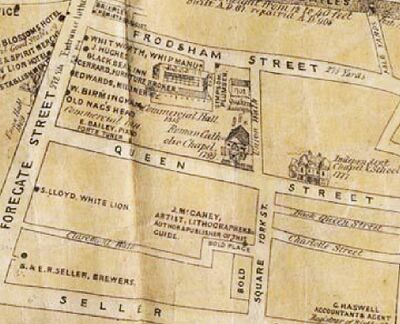Queen Street
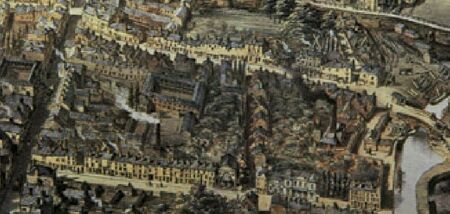
Queen Street in history
Queen Street does not appear on the Lavaux Map of 1745, but does appear on Mutlow_and_StockdaIes_Map of 1795. The evidence points to Queen Street having been constructed fairly rapidly around 1777, with much development by two individuals in particular: John Chamberlaine and Roger Rogerson. The development of the street was connected with the development of the Chester-Nantwich canal which was announced in 1771 and opened in 1779. The undeveloped land upon which the street stands was in part the old parade ground of Roman Chester and later the "Jousting Croft" and an area for archery practice. Fletcher, writing in 1791 says of it:
- "Queen street has been built within these few years its situation is pleasant and airy in it is a large well-built chapel - the place of worship of a sect of Independents, also a reputable academy for the education of youth, kept by Mrs Sellers."
Queen Street was built at the time of a hope of economic recovery in Chester which was not to happen. Between 1762 and 1840 key elements of Chester's traditional economy withered and finally died, and the city struggled to find new roles. Previously important manufacturing trades vanished and were replaced only in part by new industries. From the 1770s city development was especially concentrated north of Foregate Street, beginning with Queen Street and expanding later to include Bold Square and Seller and Egerton Streets before 1820. The port declined so drastically that by 1840 Chester's wharves were of little importance, and the city also suffered problems with its road and canal traffic. It was only the coming of the railways and the building of Chester Station at the end of this period that boom returned (see: Industrial Revolution).
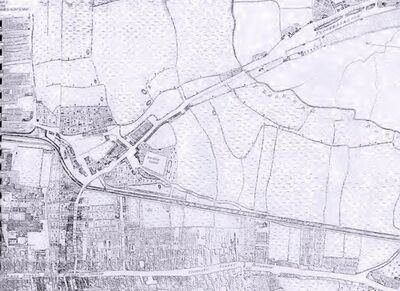
Queen Street used to extend northwards fron Foregate Street through to Canalside but was severed by the construction of a service-yard during the Tesco development. Nowadays, Queen Street lacks a coherent urban form, especially along its western side, a large portion of which is taken up by the rear servicing yard of the Boots store which is set behind a high brick wall. Development along this side of the street relates poorly to the scale of properties on the opposite side which has a stronger form, with properties (including a pleasant row of terraces), forming a more continuous frontage along the back of pavement. Queen's Place, (formerly part of Queen Street, now separated by the rebuilt Doric screen of the chapel's adjacent Lecture Hall) is Georgian in character, with some attractive two and three storey townhouses finished with Flemish bonded brown brickwork. These town-houses were lucky to survive as in 1966 (when opinions about conservation were beginning to change) the council was persuaded to abandon plans to destroy these Georgian houses.
Queen street was once linked to Frodsham Street via Union Walk. This connection was broken by the construction of the Tesco store.
Queen Street's fortunes have ebbed and flowed over the years: it was the home of the Corporation abattoir from 1925-1954 and is now sometimes considered little more than a service road for the stores on Foregate Street and Frodsham Street. However, it has played a significant role in Chester's religious history. In 1926, late first and early second century pottery was recovered from the yard of the Cold Storage Company/abattoir, Queen St., during non-archaeological excavations on the site. The area lies approximately 162m due east of the fortress wall and was formerly the site of an extensive post-medieval tannery. Finds included Samian ware and coarse ware, a spindle-whorl and a small slate counter.
Religious History
Queen Street played a significant part in the Georgian and Victorian development of religion in Chester. The only remnants of which are the surviving facades of the Independent Chapel and its associated Lecture Hall. Both the Independent Chapal and the Catholic St Werburgh's had their own graveyards, now lost under modern development.
The Independent Church
William Armitage's appointment as pastor of the Commonhall Street Independent church in 1772 marked the beginnings of modern Congregationalism in Chester. Hemingway recalls how "Mr Armitage had not taken up his residence in Chester many days before a singularly awful Providence spread an universal gloom over the city and vicinity at the same time the circumstance was overruled for valuable purposes to many". The event of which Hemingway writes was the frightful gunpowder explosion of 5th November 1772 in Watergate Street. Armitage seems to argue that:
- "Many debated in their minds whether the shew or the sermon would afford them the greatest entertainment. As I was just come to town and was entirely new to them several on this ground resolved to hear me and reserve their visit to the puppet room for a future evening. It was happy for them that they came to this resolution for that very night the place and about two hundred persons were blown into the air by the explosion of gunpowder.." - perhaps suggesting that those who chose his sermon about "burnt offerings" over the puppet show were somehow saved as a consequence.
In 1776, when it numbered c. 78 members, the congregation decided on new buildings in Queen Street. A brick chapel accommodating c. 900, a vestry, and a minister's house were built and services began on the new site in 1777, and a Congregationalist Sunday school met in Queen Street from 1803. Congregationalism became fashionable in Chester between 1813 and 1818 with the ministry of John Reynolds, a former army officer and son of "Mad" King George III's physician (Henry Reynolds), and for a while the congregation included leading families and officers from the garrison. In 1838 the Queen Street chapel was enlarged and adorned with a neo-Grecian facade of white stone with Doric columns in antis. The cost, with that of ancillary buildings, encumbered the church with debt for 20 years. The Queen Street chapel was exceptionally successful under Richard Knill (1848–57) and survived the troubled pastorate of P. C. Barker (1865–9), who alienated many of the congregation before he eventually became an Anglican priest. In 1851 the Congregationalists ranked third in numbers in Chester after the Anglicans and Wesleyans.
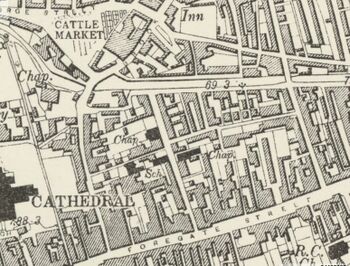
The church burned down during the very cold winter of 1963, and in 1964 the congregation was dissolved. The remains of the old building were largely demolished in 1978, except for the facade, retained as part of a Tesco supermarket, and a Doric screen from the adjacent lecture hall, resited (complete with railings) at the northern end of a truncated Queen Street.
Catholics
Until the 1750s there was no permanently resident Roman Catholic priest in Chester, masses being said either by a gentleman's chaplain, typically from Hooton Hall in Wirral or the Fitzherberts' house. From 1758, however, an almost continuous series of settled priests can be traced. In 1799 the congregation built and registered a chapel on the west side of Queen Street. It was largely paid for by the Irish merchants who headed the list of those for whom perpetual masses were afterwards said. They were very likely men who frequented Chester on business (probably the linen trade) rather than permanent residents. The "New Linenhall", a large rectangular brick building comprising small shops around a courtyard was errected on the eastern half of the Greyfriars site in 1778 by Irish linen merchants as a depot from which their cloth was distributed throughout England, Wales and Scotland, during the "boom" phase of the linen trade.

The 1848 typhus epidemic in Chester occured at the same time as a more widespread typhus epidemic which killed over 10,000 people in England and Wales and particularly affected Lancashire and Cheshire. It has been proposed that the typhus epidemic was caused by large-scale emigration from Ireland due to the potato-blight famine which was accompanied by a typhus epidemic in Ireland. Chester was a major port for travel to/from Ireland (see: Chester and Ireland) and many Irish settled in Boughton and along Canalside (Stephen Street in Boughton was already over 95% Irish in 1841, and would become the site of the "Black Sunday" "riot"). However the Chester Chronicle, even though its somewhat snobbish and anti-Irish editor Hemingway had died in 1837 was still vehemently anti-Irish in the 1840's.
Roman Catholic schools became eligible for government grants in 1847, and the St. Werburgh's schools were built in Queen Street in 1854. The fairground owner Pat Collins went to school there. The nursing order of the Little Sisters of the Assumption was established in Queen Street in 1911, building St. Augustine's convent and chapel in 1913 on land in Union Street given by a Margaret Collins (it is not known whether she was related to Pat Collins). They were succeeded there in 1957 by the Irish Sisters of Charity. The many Roman Catholic social organizations which flourished from the mid 19th century were based in the early 20th at number 34 Queen Street, which closed in 1972 and was replaced in 1975 by a social centre in the former Bowling Green Hotel in Brook Street. The old church of St. Werburgh, Queen Street, was a plain building in Classical style, of stuccoed brick with a Doric portico under a pediment, two panels with garlands decorating the upper wall, and tall roundarched windows in the side walls. An adjoining house became the presbytery and there was a burial ground to the rear. The chapel was converted into a school when a replacement church was opened in 1875 and was demolished during the redevelopment of Queen Street in 1966.
sources and links
- St Werburgh's Roman Catholic Parish (good for history and photos)
Others
The neo-Romanesque Welsh-speaking Wesleyan church in Queen Street was built in 1884. The Welsh church in Queen Street, which remained outside the Chester circuit (having transferred to the Holywell Welsh circuit in 1822), closed in 1977 and later passed to a Pentecostalist congregation. The baptist Churches of Christ, an evangelical movement centered around John Davies of Mollington, met for a while in an upper room in Queen Street in 1851.
Listed Buildings Queen's Place
Numbers 1-5 Queens Place
A row of three brick houses with painted stone plinths and grey slate roofs. They have three storeys, and each house is in a single bay. The doorcases have pilasters and a fanlight. The windows are sashes with wedge lintels
Numbers 2-4 Queens Place
A pair of brick houses from circa 1780 built on a painted stone plinth with a slate roof in three storeys. The simple doorcases are pedimented, and the windows are sashes with wedge lintels and with triple keystones.
Number 6 Queens Place
A flemish-bond brick town house of circa 1770 on a stone plinth with a grey slate roof. It is in three storeys, and has a single bay. The house has a fluted Roman Doric doorcase with a frieze, a pediment, and a fanlight. There is one 4-12-4 pane Palladian window with a three pane fan, and the other windows are sashes with wedge lintels
Number 7 Queens Place
A brick town house on a stone plinth with a slate roof. It is late 18thCent with 19thCent alterations and once included a workshop. It is in two storeys, and has a front of two bays. On the front is a doorway with an eared architrave and a blocked round-headed opening to the left of the doorway. The windows are sashes with wedge lintels.
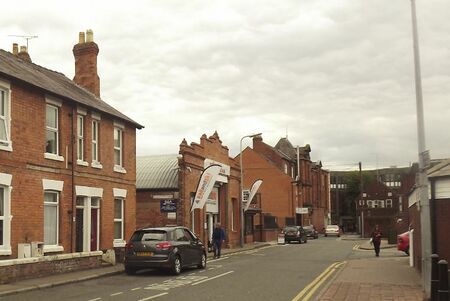
Number 9-15 Queens Place
Two 1779 (the date is on rainwater pipe which also has an ornate cast rainwater head) town houses of separate build later converted into student accomodation. They are in brick with a painted stone plinth and a grey slate roof. The flats are in three storeys, with a two-storey wing to the left. The doorcases each have fluted pilasters, a frieze, and a pediment. The windows are sashes with rusticated wedge lintels having projecting keystones.
Listed Buildings Queen's Street
Number 2 Queen Street
This building is a shop on the ground floor and a Masonic Lodge above. This stone dressed, Flemish bond brick structure dates from the early 18th Century and the frontage to Queen street was re-done in 1883. There is a three bay arcade to Foregate Street. Inside, the first floor is a dining room with a lodge meeting room above it on the second floor.
The University Lodge of Chester was formed from Temple Lodge Number 4477 in March 2011. Temple Lodge was founded on the 12th of February 1923 at the Masonic Hall, Oliver Street, Birkenhead as the Daughter Lodge of Baron Egerton Lodge No. 3513. In April 2011 the request to change the name from Temple Lodge to the "University Lodge of Chester No. 4477" was granted. The plan was to form a Lodge, in the university city of Chester, to become part of the Universities Scheme of the United Grand Lodge of England.
sources and links
Numbers 24-26 Queen Street
A pair of brick town houses from circa 1770. Each is on a stone plinth with cellar vents with a slate roof. They are in three storeys with cellars. The doorways are in paired architraves, and the windows are sashes with rusticated wedge lintels and keystones.






